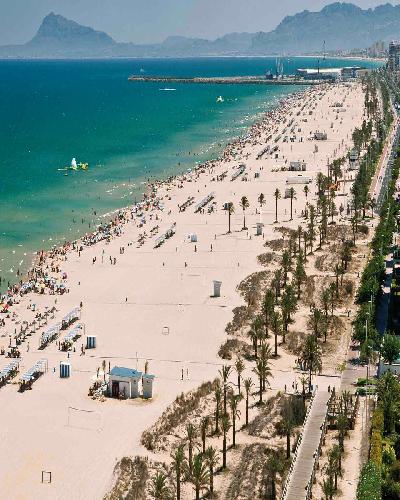 Gandía is a spa in the province of Valencia, Catalonia. The population of the city has a little more than 70,000 people, it is located about 3 km from the sea, on the Costa del Azar, 65 km south of Valencia and 116 km north of Alicante, in the middle of the area de la Safor, between the sea and the mountains. The city is located at an altitude of 22 m above sea level. It cannot be said that the city is an important tourist center of the region, since there are not many attractions or nightlife. However, every summer several thousand Europeans strive to come and relax on the seashore surrounded by beautiful nature.
Gandía is a spa in the province of Valencia, Catalonia. The population of the city has a little more than 70,000 people, it is located about 3 km from the sea, on the Costa del Azar, 65 km south of Valencia and 116 km north of Alicante, in the middle of the area de la Safor, between the sea and the mountains. The city is located at an altitude of 22 m above sea level. It cannot be said that the city is an important tourist center of the region, since there are not many attractions or nightlife. However, every summer several thousand Europeans strive to come and relax on the seashore surrounded by beautiful nature.
Many think that the city of Gandía received its name in honor of the famous Indian politician Mahatma Gandhi, but it is not. The name comes from a fusion of several Catalan and Spanish words. Gandía is a small and typical tourist center in Spain, where the old town is well preserved and there are a couple of interesting places.
Gandía is obviously not the best place for a tourist vacation, but it is ideal if you want to have a beach vacation
The history of Gandía goes back to the time of the Muslim power. In 1240, Jaime I conquered the Roman fortress of Castell Bairen, which at that time belonged to the Arabs (the ruins of Bairen still stand on a hill at the entrance to Gandía). In 1485 this land was bought by Rodrigo Borgia (Pope Alexander VI) for his son Pedro Luis, who became the first Duke of Gandia, since then the heyday of the city began.
The crisis in Gandía at the end of the 16th century contributed to the debt of the nobility, to the lack of cash, to the plague epidemic. The eighteenth century in the history of the city was marked by a fierce political struggle. The new apogee began after the opening of the port (1886) and the railroad (1893). The tourism industry began to develop in the 1960s.
Palace of the Dukes of Borgia:
The most important and famous attraction in Gandia is the Palace of the Dukes of Borgia. It is a family nest, where 11 generations of this family were born and lived. Interestingly, the history of the palace did not begin in 1485, when the first Borgia arrived, but much earlier, in the early fourteenth century, when it was built by the Aragonese kings.
The exterior decoration of the attraction cannot be called very beautiful or real - a simple three-story house made of sandstone. However, if you enter the courtyard, you can already see some features of the rich house from the XV and XVI centuries: an elegant stone well in the center of the patio, a large front staircase in marble and sandstone, a small garden . But the interior decoration of the attraction will leave no doubt that a rich noble family lived here.
Galería Faller Museum:
All tourists agree that the Faller Museum in Gandía is the most interesting museum in Gandía. Here you can see hundreds of original sculptures and dolls representing famous people.
However, it is not that simple - all these dolls are not only part of beautiful exhibitions, but important elements of the mask processions that are regularly held in Gandía. Tourists will learn who and how makes these original sculptures because of what they are used for in town festivals.
Prado Square:
El Prado is the central square of Gandia, where every weekend there is a small farmers market and several family cafes. There are many elegant boutiques and well-kept courtyards near the plaza. There are always many tourists in this part of Gandía, but there are almost no places of interest.
Port and embankment:
The Gandía seafront is considered one of the widest and most beautiful in Catalonia. Here you can walk, sit in one of the cafes, look in a small boutique, as well as admire the bright flowers on the beds. The promenade has plenty of benches and loungers to relax in and there are gyms and play areas for children.
Gandía Beach:
This is the central beach, located in the heart of the city. There are many tourists here, but there is enough space for everyone. The approximate length of the beach is about 3 km and its width is at least 130 meters.
The sand of Gandía beach is fine and golden, the entrance of water is soft. There are no rocks or stones in this part of the Costa Blanca. The water is very clean and during the period of inactivity it is absolutely transparent. There are no infrastructure problems, there are cafes, sun beds, showers and toilets. A picturesque promenade stretches along the beach.
Keep in mind that in Playa de Gandía there is no water entertainment - this place is created for a quiet holiday.
